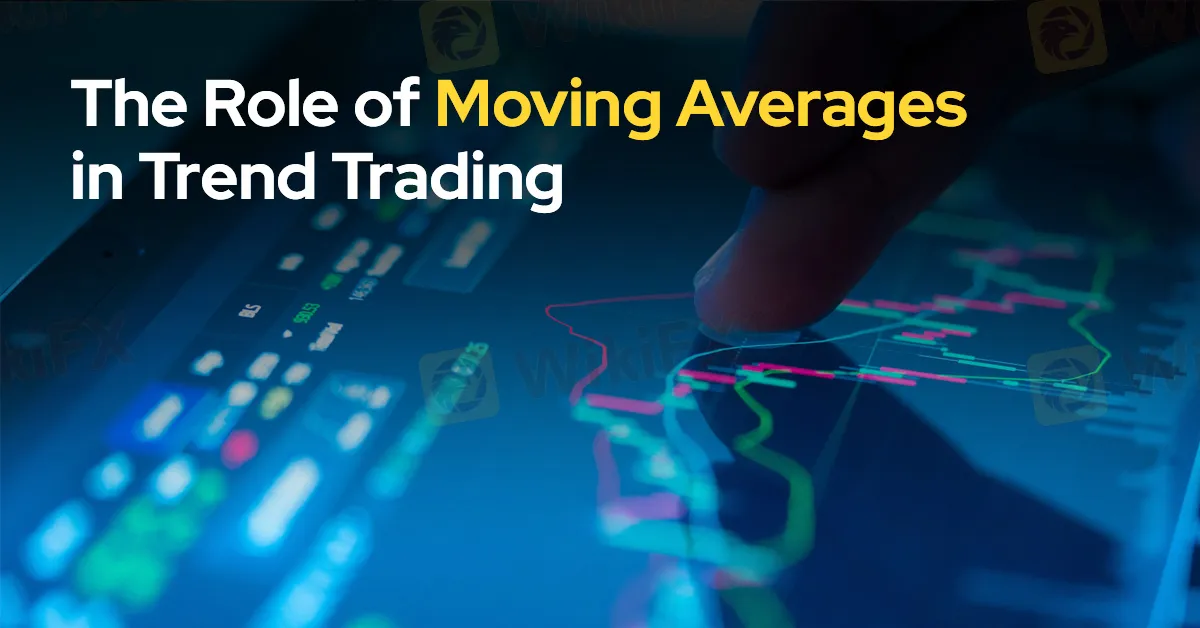简体中文
繁體中文
English
Pусский
日本語
ภาษาไทย
Tiếng Việt
Bahasa Indonesia
Español
हिन्दी
Filippiiniläinen
Français
Deutsch
Português
Türkçe
한국어
العربية
The Role of Moving Averages in Trend Trading
Abstract:Moving averages are essential tools in technical analysis, widely used by traders to identify trends and make informed decisions. By smoothing out price data, moving averages help traders filter out noise and determine the overall direction of a market, making them invaluable in trend trading strategies.

Introduction
Moving averages are essential tools in technical analysis, widely used by traders to identify trends and make informed decisions. By smoothing out price data, moving averages help traders filter out noise and determine the overall direction of a market, making them invaluable in trend trading strategies.
What are Moving Averages?
A moving average (MA) is a statistical calculation that averages a set of data points over a specific period. In trading, the most common types are:
Simple Moving Average (SMA): This is calculated by summing the closing prices over a designated number of periods and dividing by that number. It provides a straightforward average but can lag behind current prices.
Exponential Moving Average (EMA): This gives more weight to recent prices, making it more responsive to new information. EMAs are favored by many traders for their sensitivity to price changes.
Identifying Trends with Moving Averages
Moving averages are primarily used to identify market trends. Heres how they can aid trend trading:
Trend Direction: When prices are above the moving average, it generally indicates an uptrend, while prices below suggest a downtrend. This visual representation helps traders align their positions with the prevailing trend.
Crossovers: One of the most popular strategies involves using two moving averages—a shorter period and a longer period. A bullish crossover occurs when the shorter MA crosses above the longer MA, signaling a potential buy opportunity. Conversely, a bearish crossover happens when the shorter MA crosses below the longer MA, indicating a potential sell signal.
Support and Resistance Levels: Moving averages can act as dynamic support and resistance levels. In an uptrend, the moving average may serve as support, while in a downtrend, it can act as resistance. Traders often look for price action around these averages to make decisions.
Combining Moving Averages with Other Indicators
While moving averages are powerful on their own, they are often more effective when combined with other technical indicators. For example:
Relative Strength Index (RSI): This momentum oscillator can help confirm trends identified by moving averages. A bullish signal is stronger when the RSI is above 50, while a bearish signal is confirmed when its below 50.
MACD (Moving Average Convergence Divergence): This indicator uses moving averages to identify momentum and trend changes. Traders can look for crossovers and divergence between MACD and price action for additional confirmation.
Limitations of Moving Averages
Despite their usefulness, moving averages have some limitations:
Lagging Indicator: Moving averages are lagging indicators, meaning they react to price changes rather than predict them. This delay can result in late entry or exit points.
Whipsaws in Sideways Markets: In choppy or sideways markets, moving averages can produce false signals, leading to potential losses.
Parameter Sensitivity: The effectiveness of moving averages depends on the chosen time period. Shorter periods can generate more signals but may also increase noise, while longer periods smooth out fluctuations but can delay signals.
Conclusion
Moving averages play a crucial role in trend trading, helping traders identify and capitalize on market trends. By providing insights into trend direction, potential entry and exit points, and acting as dynamic support and resistance, moving averages can enhance trading strategies. However, traders should be mindful of their limitations and consider combining them with other indicators to improve overall effectiveness. Understanding how to leverage moving averages can significantly enhance a trader's ability to navigate the ever-changing forex market.

Disclaimer:
The views in this article only represent the author's personal views, and do not constitute investment advice on this platform. This platform does not guarantee the accuracy, completeness and timeliness of the information in the article, and will not be liable for any loss caused by the use of or reliance on the information in the article.
Read more

Octa Unveils Festive Promotion with Bonuses and Prizes This December
Octa, a globally licensed broker, has announced its ‘Octa New Year’ promotional campaign, running from 2 to 27 December 2024. The initiative, guided by the theme ‘Trading that feels like home’, offers deposit bonuses, reduced spreads, and a live prize draw to enrich the trading experience during the holiday season.
Share Industry Insights and Discuss Forex Market Trends-Philippines
This month, we are excited to announce the posting activity, Share Industry Insights and Discuss Forex Market Trends! Share your Forex insights and not only grow alongside thousands of traders, but also have the chance to win generous rewards! Make your trading journey truly exciting — come join us now!
Share Industry Insights and Discuss Forex Market Trends - India
This month, we are excited to announce the posting activity, Share Industry Insights and Discuss Forex Market Trends! Share your Forex insights and not only grow alongside thousands of traders, but also have the chance to win generous rewards! Make your trading journey truly exciting — come join us now!

Why Market Liquidity is Crucial for Every Trader
Discover the importance of market liquidity for traders. Learn how bid and ask liquidity impacts prices and trading decisions in the financial world.
WikiFX Broker
Latest News
Multiple foreign currencies were seized at an Indian airport
MT5 IS BACK! Now Available on Play Store in India
Trump Appoints David Sacks as AI & Crypto Czar
Who Are the Top FX Traders in Malaysia?
Forex Price Trend Prediction
Crypto.com Eyes MENA Growth with Abu Dhabi Acquisition
NY Approves Ripple RLUSD Stablecoin, Trump Predicts $1M BTC
LiteForex Review!! Read First, Invest Later
Warning Against Kwakol Markets
South Korean Film 'Crypto Man' to Premiere in January 2025
Currency Calculator


